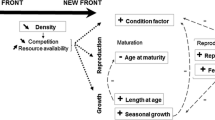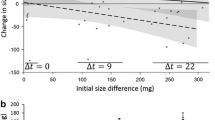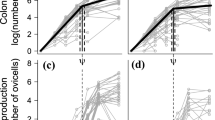Abstract
The theory of cannibal dynamics predicts a link between population dynamics and individual life history. In particular, increased individual growth has, in both modeling and empirical studies, been shown to result from a destabilization of population dynamics. We used data from a long-term study of the dynamics of two leech (Erpobdella octoculata) populations to test the hypothesis that maximum size should be higher in a cycling population; one of the study populations exhibited a delayed feedback cycle while the other population showed no sign of cyclicity. A hump-shaped relationship between individual mass of 1-year-old leeches and offspring density the previous year was present in both populations. As predicted from the theory, the maximum mass of individuals was much larger in the fluctuating population. In contrast to predictions, the higher growth rate was not related to energy extraction from cannibalism. Instead, the higher individual mass is suggested to be due to increased availability of resources due to a niche widening with increased individual body mass. The larger individual mass in the fluctuating population was related to a stronger correlation between the densities of 1-year-old individuals and 2-year-old individuals the following year in this population. Although cannibalism was the major mechanism regulating population dynamics, its importance was negligible in terms of providing cannibalizing individuals with energy subsequently increasing their fecundity. Instead, the study identifies a need for theoretical and empirical studies on the largely unstudied interplay between ontogenetic niche shifts and cannibalistic population dynamics.





Similar content being viewed by others
References
Claessen D, De Roos AM, Persson L (2000) Dwarfs and giants—cannibalism and competition in size-structured populations. Am Nat 155:219–237
Claessen D, van Oss C, De Roos AM, Persson L (2002) The impact of size-dependent predation on population dynamics and individual life history. Ecology 83:1660–1675
Claessen D, De Roos AM, Persson L (2004) Population dynamic theory of size-dependent cannibalism. Proc Biol Sci 271:333–340
Costantino RF, Desharnais RA, Cushing JM, Dennis B (1997) Chaotic dynamics in an insect population. Science 275:389–391
Cushing JM (1991) A simple model of cannibalism. Math Biosc 107:47–71
DeAngelis DL, Rose K, Crowder LB, Marschall EA, Lika D (1993) Fish cohort dynamics: application of complementary modeling approaches. Am Nat 142:604–622
Denoël M, Whiteman HH, Wissinger SA (2006) Temporal shift of diet in alternative cannibalistic morphs of the tiger salamander. Biol J Linn Soc 89:373–382
Elgar MA, Crespi BJ (1992) Cannibalism. Ecology and evolution among diverse taxa. Oxford University Press, Oxford
Elliott JM (1973a) The life cycle and production of the leech Erpobdella octoculata (L.) (Hirudinea: Erpobdellidae) in a Lake District stream. J Anim Ecol 42:435–448
Elliott JM (1973b) The diel activity pattern, drifting and food of the leech Erpobdella octoculata (L.) (Hirudinea: Erpobdellidae) in a Lake District stream. J Anim Ecol 42:449–459
Elliott JM (2004) Contrasting dynamics in two subpopulations of a leech metapopulation over 25 year-classes in a small stream. J Anim Ecol 73:272–282
Fox LR (1975) Cannibalism in natural populations. Annu Rev Ecol Syst 6:87–106
Huss M, Byström P, Persson L (2010) Growing through predation windows: effects on body size development in young fish. Oikos 119:1796–1804
Kohlmeier C, Ebenhöh W (1995) The stabilizing role of cannibalism in a predator–prey system. Bull Math Biol 57:401–411
Kutschera U (1989) Innerartliche Kokonzerstörung beim Eigel Erpobdella octoculata. Beob Aquarienkultur Mikrokosmos 78:237–241
Kutschera U, Wirtz P (2001) The evolution of parental care in freshwater leeches. Theor Biosci 120:115–137
Le Cren ED (1992) Exceptionally big individual perch (Perca fluviatilis L.) and their growth. J Fish Biol 40:599–625
Macan TT (1958) Methods of sampling the bottom fauna in stony streams. Mitt Int Ver Theor Angew Limnol 8:1–21
Maltby L, Calow P (1986) Intraspecific life-history variation in Erpobdella octoculata (Hirudinea: Erpobdellidae). I. Field study. J Anim Ecol 55:721–738
Murdoch WW, Kendall BE, Nisbet RM, Briggs CJ, McCauley E, Bolser R (2002) Single-species models for many-species food webs. Nature 417:541–543
Persson L, Eklöv P (1995) Prey refuges affecting interactions between piscivorous perch and juvenile perch and roach. Ecology 76:70–81
Persson L, Leonardsson K, De Roos AM, Gyllenberg M, Christensen B (1998) Ontogenetic scaling of foraging rates and the dynamics of a size-structured consumer-resource model. Theor Pop Biol 54:270–293
Persson L, De Roos AM, Claessen D, Byström P, Lövgren J, Svanbäck R, Wahlström E, Westman E (2003) Gigantic cannibals driving a whole lake trophic cascade. Proc Natl Acad Sci USA 100:4035–4039
Persson L, Claessen D, De Roos AM, Byström P, Sjögren S, Svanbäck R, Wahlström E, Westman E (2004) Cannibalism in a size-structured population—energy extraction and control. Ecol Monogr 74:135–157
Polis GA (1981) The evolution and dynamics of intraspecific predation. Annu Rev Ecol Syst 12:225–251
Post DM (2003) Individual variation in the timing of ontogenetic niche shifts in largemouth bass. Ecology 84:1298–1310
Preisser EL, Bolnick DI, Benard MF (2005) Scared to death? The effects of intimidation and consumption in predator–prey interactions. Ecology 86:501–509
Ricker WW (1954) Stock and recruitment. J Fish Res Bd Can 11:559–623
Schellekens T, De Roos AM, Persson L (2010) Ontogenetic niche shifts result in niche partitioning between two consumer species. Am Nat 176:625–637
Stearns SC (1992) The evolution of life histories. Oxford University Press, Oxford
Surber EW (1934) A quantitative net for collecting bottom animals in streams. Washington Bureau of Fisheries, USA, pp 1–4
Tian T, Fiksen Ø, Folkvord A (2007) Estimating larval fish growth under size dependent mortality: a numerical analysis of bias. Can J Fish Aquat Sci 64:554–562
Toman MJ, Dall PC (1997) The diet of Erpobdella octoculata (Hirudinea: Erpobdellidae) in two Danish lowland streams. Arch Hydrobiol 140:549–563
van Kooten T, Persson L, De Roos AM (2007) Size selective harvesting of a cannibalistic population: population dynamics and life history. Am Nat 170:258–270
van Kooten T, Andersson J, Byström P, Persson L, De Roos AM (2010) Size at hatching determines population dynamics and response to harvesting in cannibalistic fish. Can J Fish Aquat Sci 67:401–416
Werner EE, Gilliam JF (1984) The ontogenetic niche and species interactions in size-structured populations. Annu Rev Ecol Syst 15:393–425
Wilson DS (1975) The adequacy of body size as a niche difference. Am Nat 109:769–784
Wissinger SA, Whiteman HH, Denoël M, Mumford ML, Aubee CB (2010) Consumptive and nonconsumptive effects of cannibalism in fluctuating age-structured populations. Ecology 91:549–559
Young JO (1988) Intra- and interspecific predation on the cocoons of Erpobdella octoculata (L.) (Annelida: Hirudinea). Hydrobiologia 169:85–89
Acknowledgments
A large number of people helped with the sampling, and we are especially grateful to Derek Allonby, Alex Elliott, Judith Elliott, Uwe Humpesch, and Paula Tullett. We thank the reviewers for useful comments that improved the clarity of the paper. Malcolm Elliott was supported by the Natural Environment Research Council through a grant to the Freshwater Biological Association, and Lennart Persson was supported by a grant from the Swedish Research Council.
Author information
Authors and Affiliations
Corresponding author
Additional information
Communicated by Øyvind Fiksen.
Rights and permissions
About this article
Cite this article
Persson, L., Elliott, J.M. Population variation and individual maximum size in two leech populations: energy extraction from cannibalism or niche widening?. Oecologia 172, 119–127 (2013). https://doi.org/10.1007/s00442-012-2468-8
Received:
Accepted:
Published:
Issue Date:
DOI: https://doi.org/10.1007/s00442-012-2468-8




